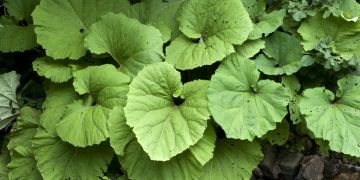Latin Name
Petasites hybridus
Common Names
Common butterbur, sweet coltsfoot, blatterdock, bogshorns, butter-dock, butterfly dock, capdockin, flapperdock, langwort, umbrella plant.
Indicated for
Headache and inflammation, severity of migraines, seasonal allergies such as itchy eyes, itchy and runny nose, and nasal congestion.
Properties
Anti-spasmodic, anti-inflammatory, cardio tonic, diaphoretic, diuretic, and leaves that function as an analgesic.
Historically, in the sixteenth century, Butterbur as a dried powder was mixed with wine to fight in the battle against the plague and other virulent diseases. It was also used as a treatment for worms as a form of diuretic, the spurring on of menstruation, and by Native Americans as a herbal remedy for headache and inflammation. Other uses were for urinary tract issues, wound healing and back pain. Butterbur has been in use for over 2,000 years. The name Butterbur comes from the use of wrapping butter in its large leaves during the warm weather.
Studies show that Butterbur is currently most effective for the treatment of headaches and inflammation, severity of migraines and hay fever. It is important to note that Butterbur has not been proven to treat all allergies, only seasonal allergies which include itchy eyes and noses, sneezing, runny noses and nasal congestion. Additional research is necessary to determine if Butterbur is safe and can eventually be used for year-round allergies such as mold, dust or animal dander.
Each part of the Butterbur plant is very important. The leaves, roots, flowers and stems are all used for medicinal purposes in some way. For example, when taken orally, studies show a specific extract from the root of the Butterbur over a four month period can lessen the relentlessness of headache pain and the duration of these headaches as they occur. The leaf extract of Butterbur decreases nose discomfort.
Butterbur can be taken in several different forms. It can be eaten, given as a powder, in pill form, in tea or as a tincture. However, it is very imperative to note that Butterbur contains pyrrolizidine alkaloids which are toxic chemicals. Pyrrolizidine alkaloids are created by plants to defend them against the feeding frenzy of insect herbivores. These toxic chemicals may cause liver damage or cancer to the liver. When purchasing Butterbur products, consult your physician first and make sure that your purchase is labeled: Pyrrolizidine alkaloid or PA-free. An effective dosage of Butterbur is 50 to 75 mg twice a day.





